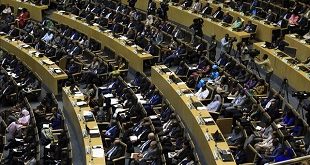
By Independent Reporter
Slow reaction to `mysterious’ disease proves fatal
Two months after the deadly Ebola virus struck in May, it has hit again, this time in Kibaale district in western Uganda.
In an address to the nation on July 29 after at least 14 had been confirmed dead, President Yoweri Museveni confirmed the latest outbreak and appeared to blame its quick spread on the failure by medical personnel to detect it early. He contrasted it with the case of a girl who contracted and died of ebola at the Bombo Military Hospital in Luweero but there were no other victims because the case was detected early by the doctors.
“The doctors in Kibaale say the symptoms were a bit atypical of Ebola,” the President said, “Because of that delay, the sickness spread to another village called Kibaari and to another village called Kisindiizi. Some people went to Kagadi hospital and at least one or two went to Mulago Hospital.”
At the time, he said, the Ministry of Health officials were tracing all the people that have had contact with the victims, including the seven doctors that dealt with one of the people who reported to Mulago and died and the thirteen health workers who were accompanying them.
He appealed to the public to be on the lookout for illness that has symptoms like high fever, bleeding, vomiting.
“Avoid shaking of hands, do not take on burying somebody who has died from symptoms which look like Ebola instead call the health workers to be the ones to do it and avoid promiscuity because these sicknesses can also go through sex,” he said.
A CDC factsheet on Ebola says the disease is “characterized by fever, headache, joint and muscle aches, sore throat, and weakness, followed by diarrhea, vomiting, and stomach pain. A rash, red eyes, hiccups and internal and external bleeding may be seen in some patients.”
The 12-year old girl who died of ebola in May was from Nakisamata village in Zirobwe sub-county, Luwero district. The ebola strain in the outbreak is the Sudanic ebola, which has a 50-60 percent fatality rate.
Ebola factsheet
Ebola, which which manifests itself as a hemorrhagic fever, is highly infectious, and kills quickly has no cure or vaccine.
It was first reported in 1976 in Congo and is named for the river where it was recognised, according to the Centers for Disease Control and Prevention.
Scientists don’t know the natural reservoir of the virus, but they suspect the first victim in an Ebola outbreak gets infected through contact with an infected animal, such as a monkey.
The virus can be transmitted through direct contact with the blood or secretions of an infected person, or objects that have been contaminated with infected secretions.
Ebola was first confirmed in Uganda in Gulu in 2000. Other areas that have been in the past include Mbarara and Masindi in 2000 and Bundibugyo in 2007 to 2008.
Incubation period: Two to 21 days
Diagnosis: Confirmation is by laboratory testing at the reference laboratory at the Uganda Virus research Institute.
Treatment and vaccine
There is no specific treatment or vaccine is yet available for Ebola. Urgently seek care from a qualified health facility where supportive care in form of intravenous fluids or oral re-hydration solutions, blood transfusions, and other necessary life support can be provided.
Occurrence: Tropical regions in Africa. Countries with confirmed human cases of Ebola hemorrhagic fever: Republic of Congo, Côte d’Ivoire, Democratic Republic of Congo, Gabon, Sudan, and Uganda.
Interventions by the Ministry of health
Surveillance- the ministry looks for contacts and tracks them. This includes persons who have come close to the patients.
Social mobilization and awareness creation and this is done through village health teams. The ministry has also put in place a committee on Ebola.

 The Independent Uganda: You get the Truth we Pay the Price
The Independent Uganda: You get the Truth we Pay the Price


